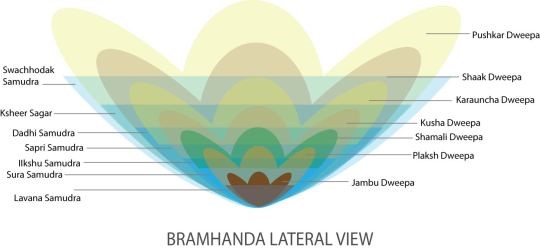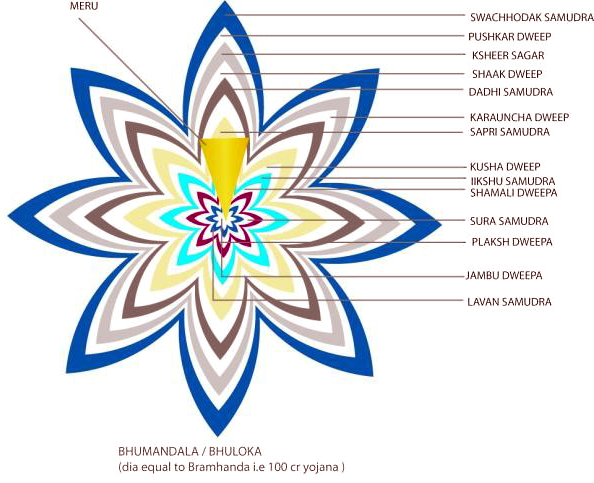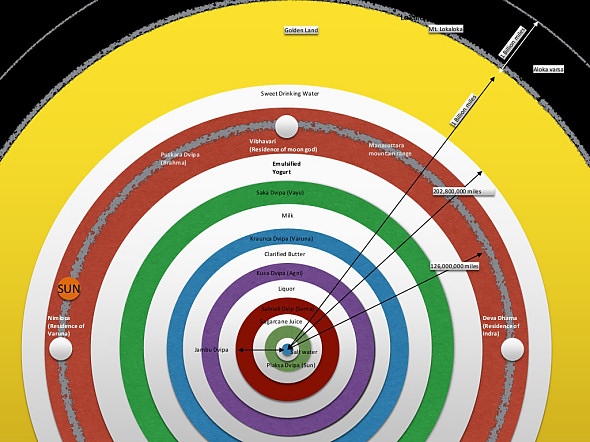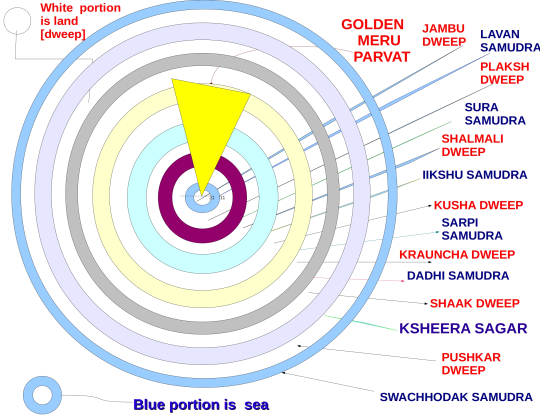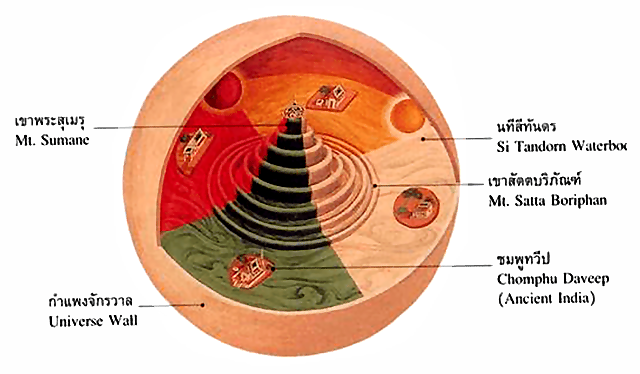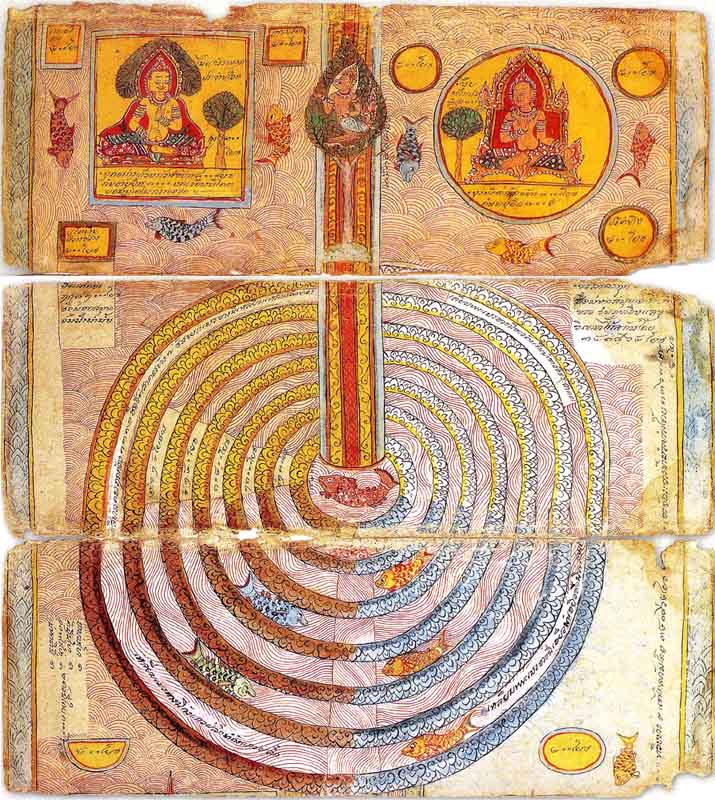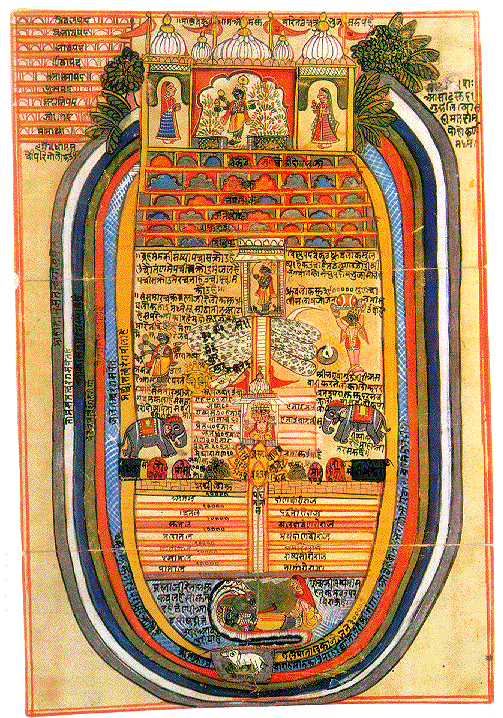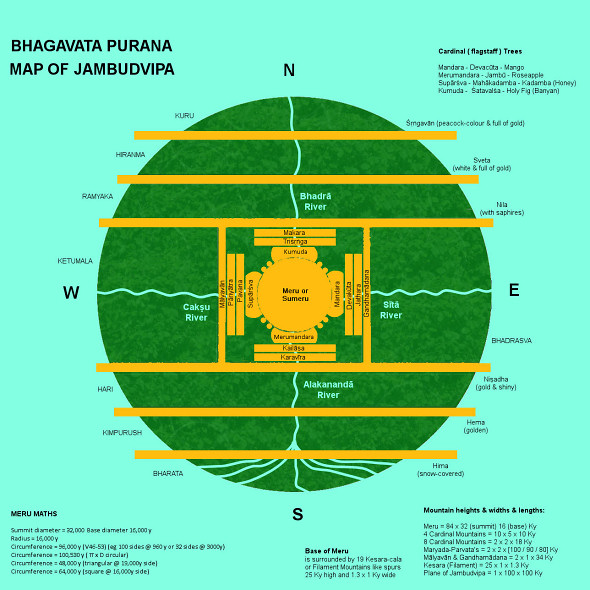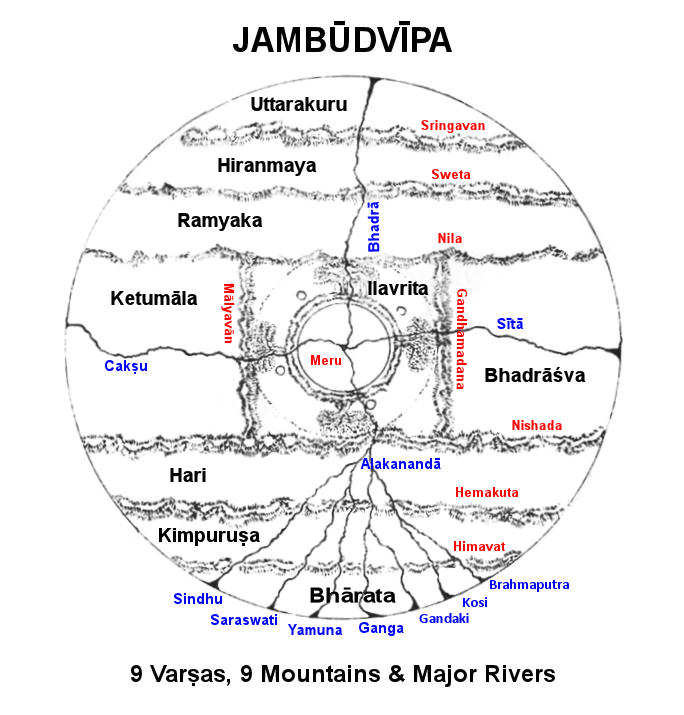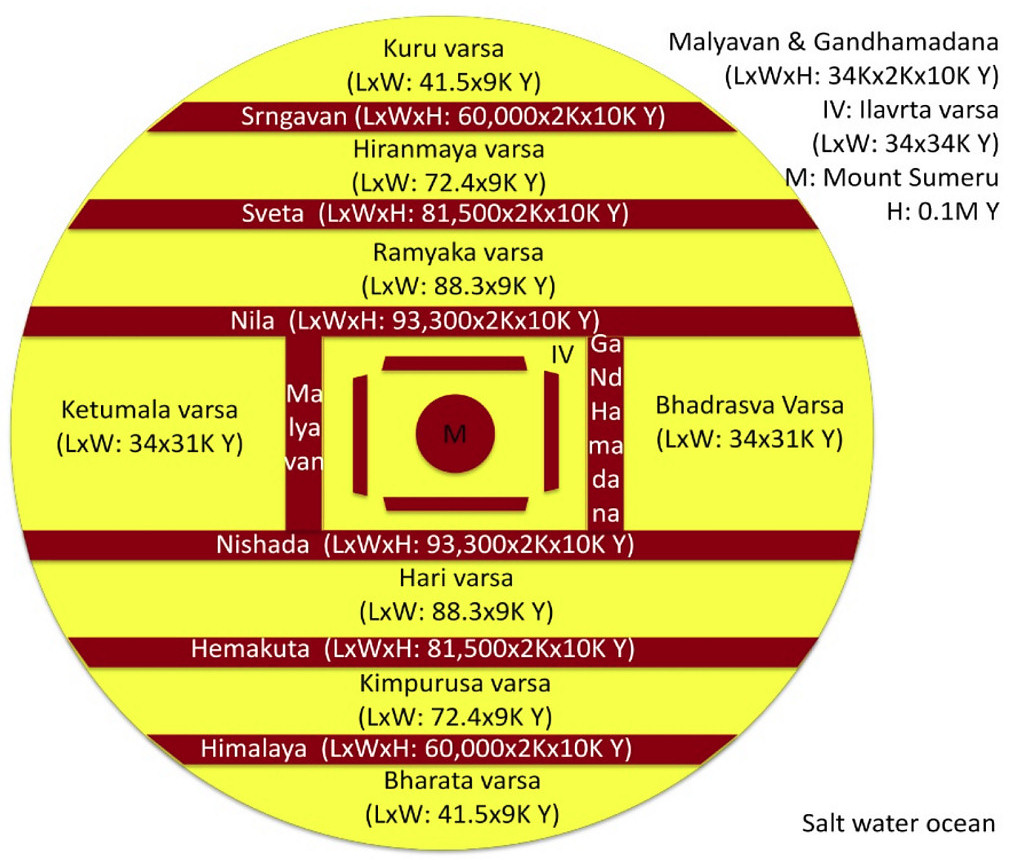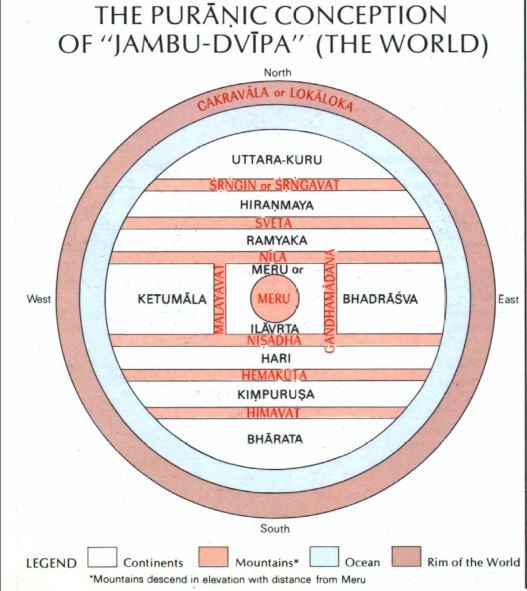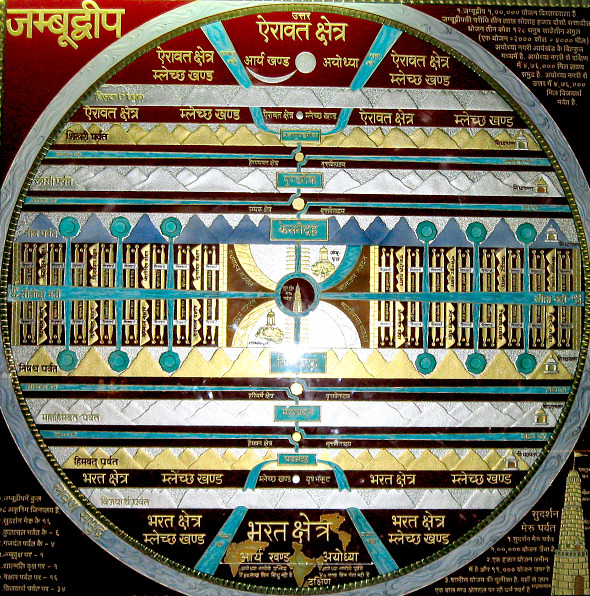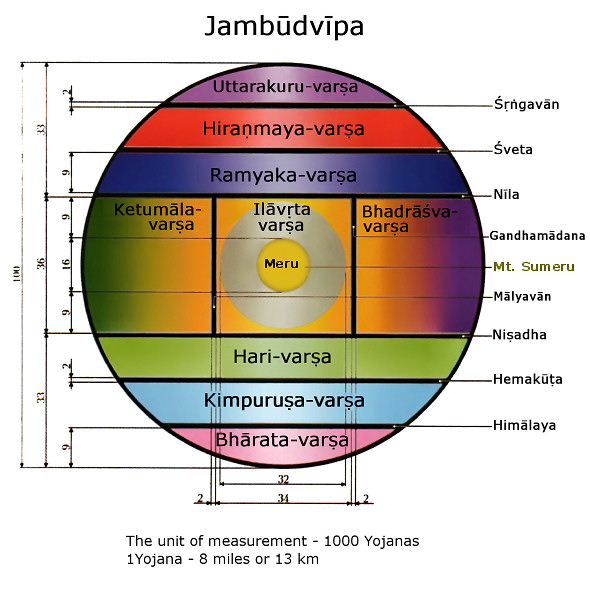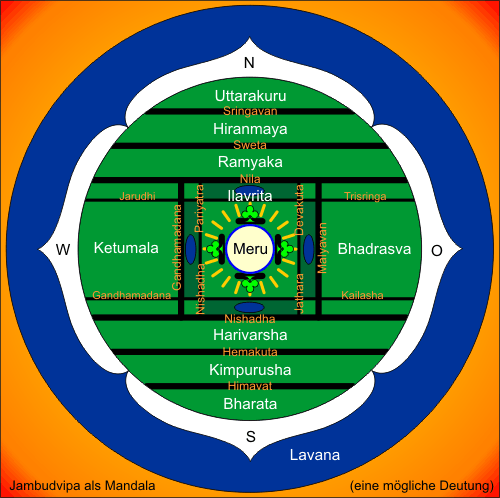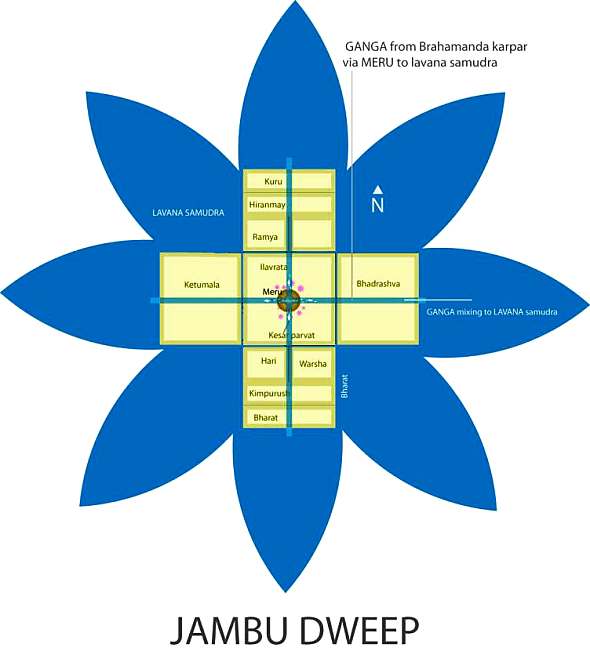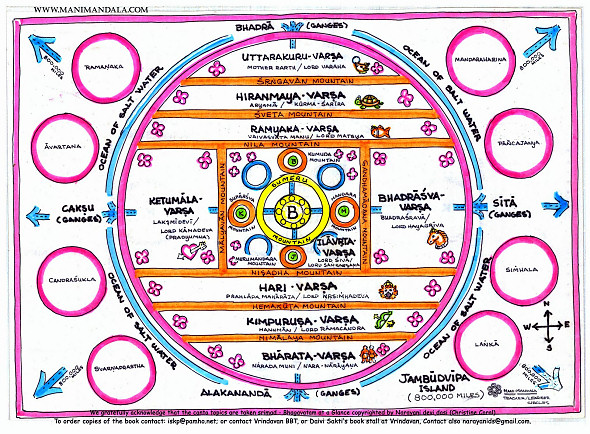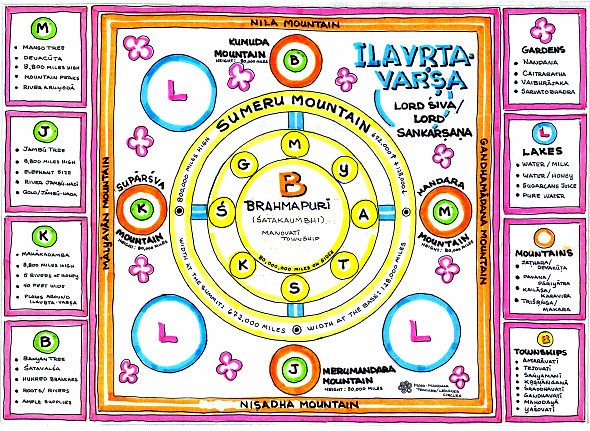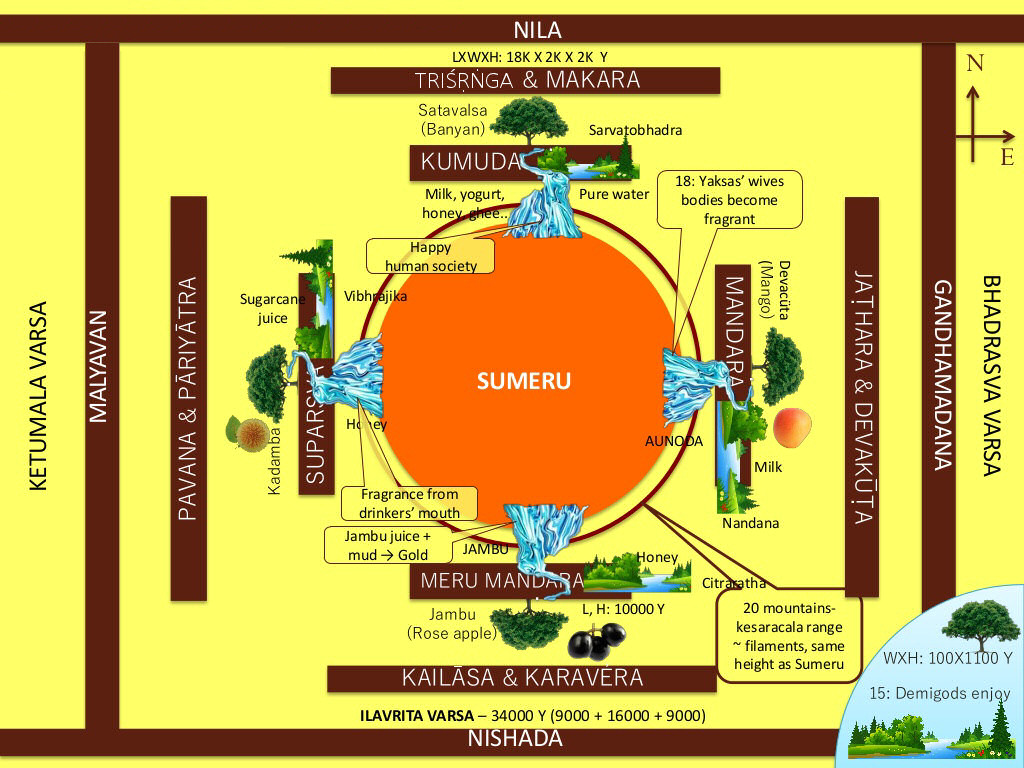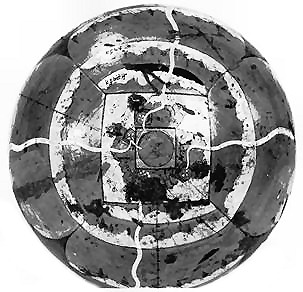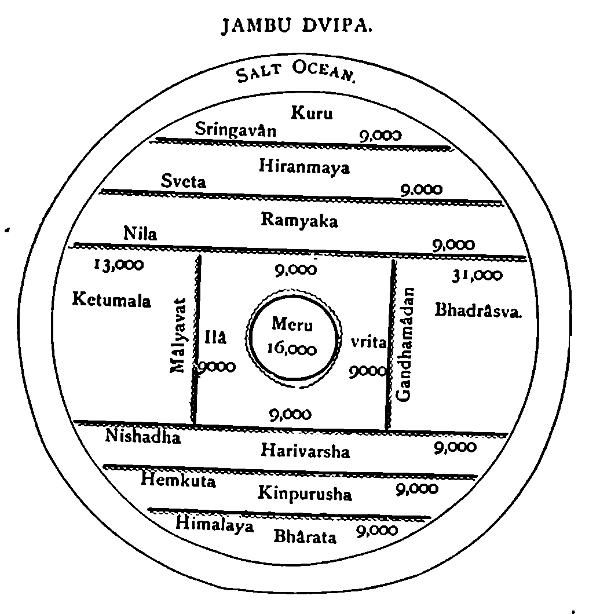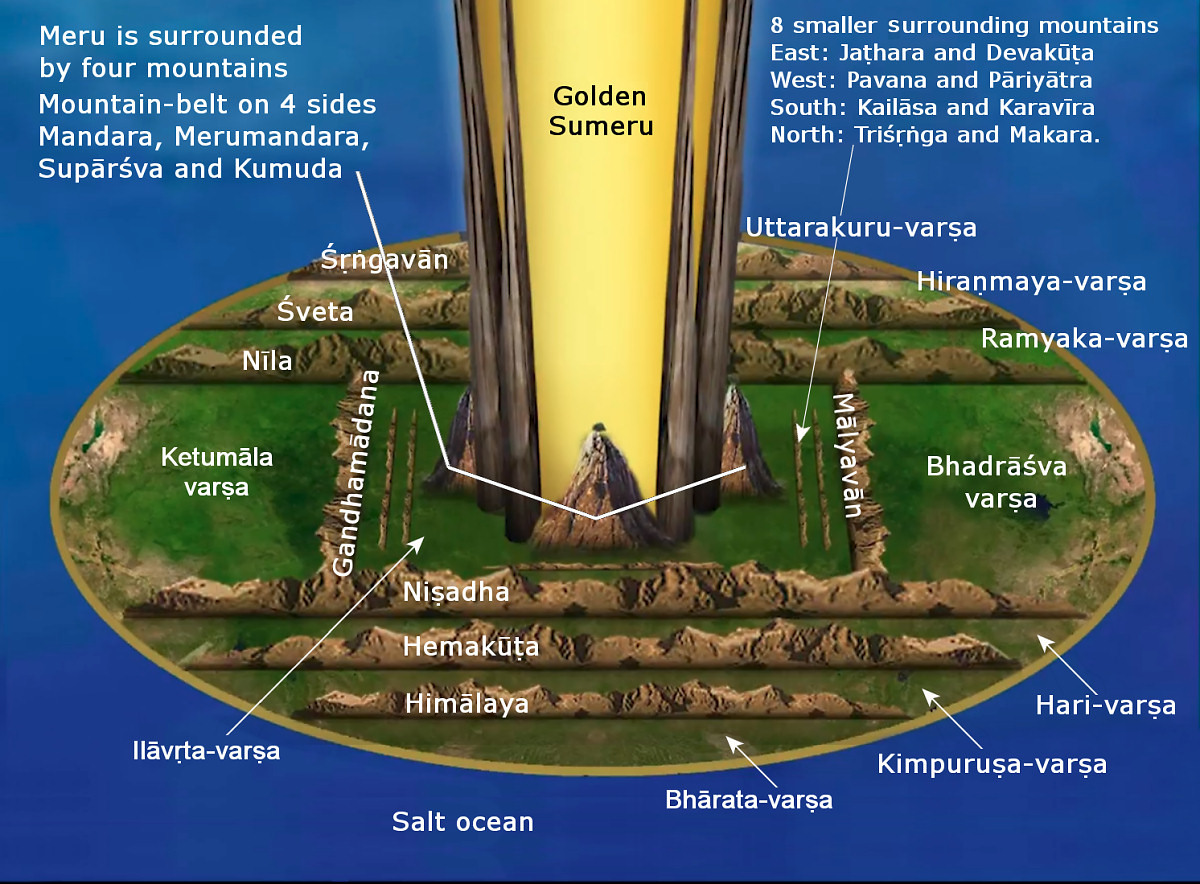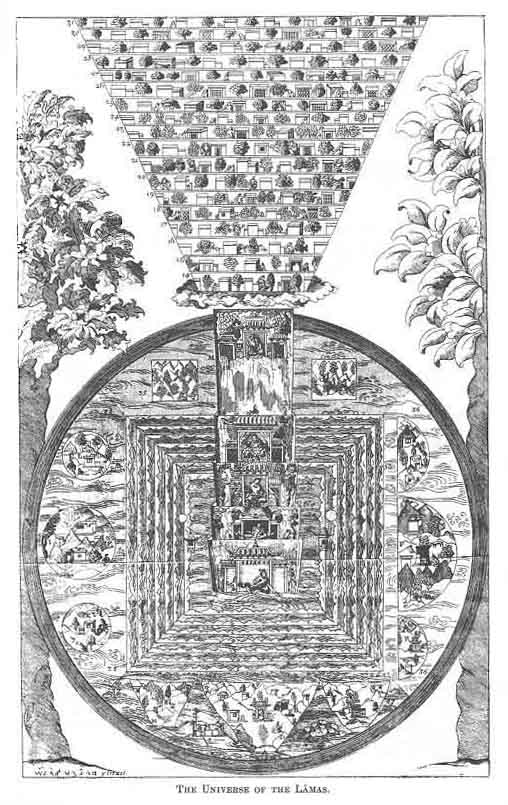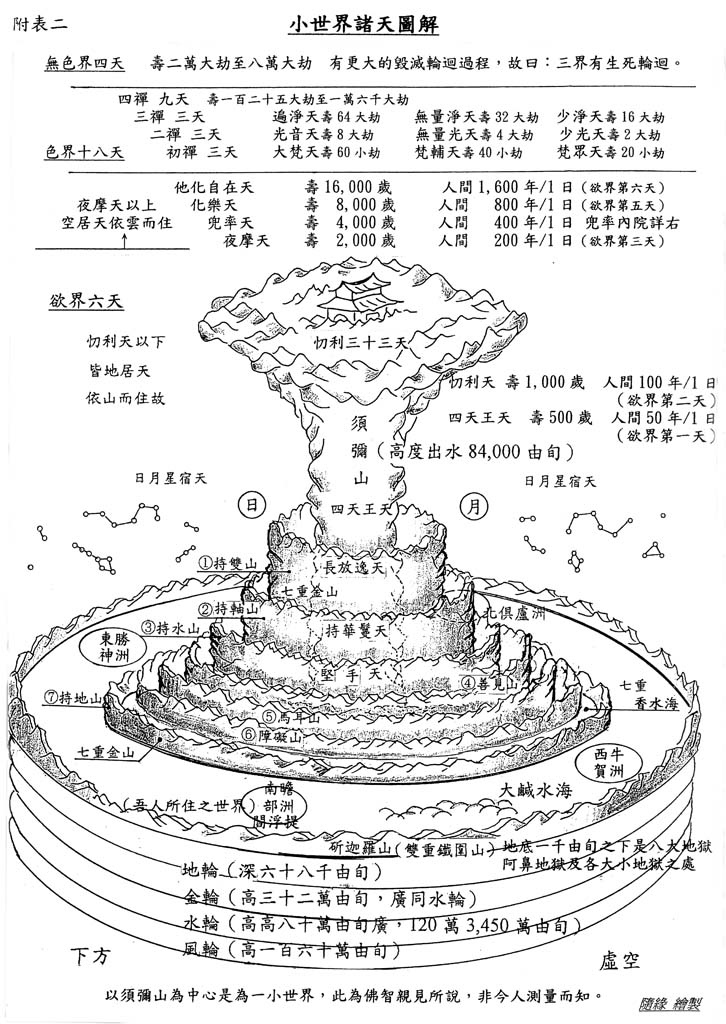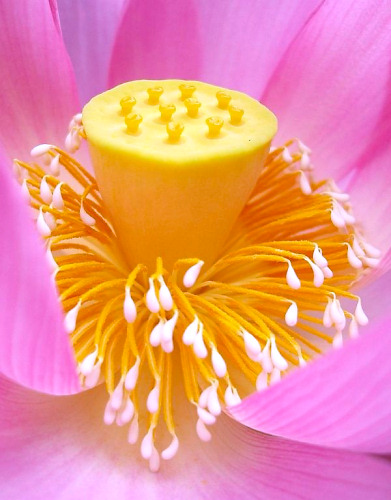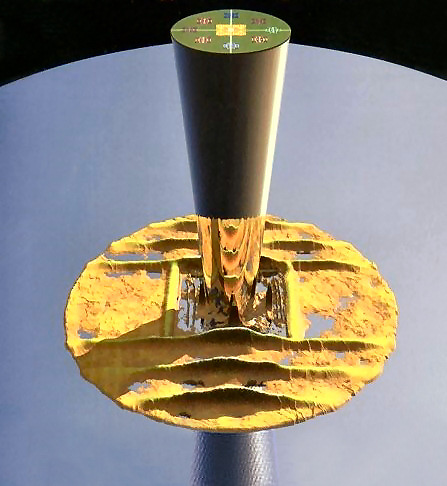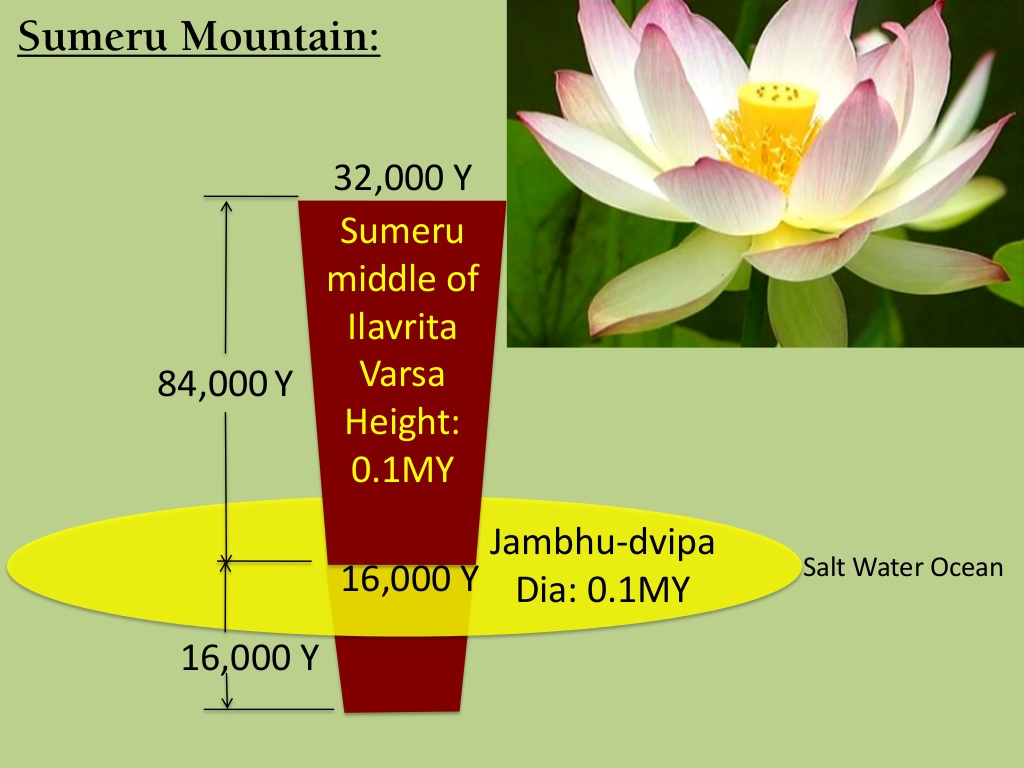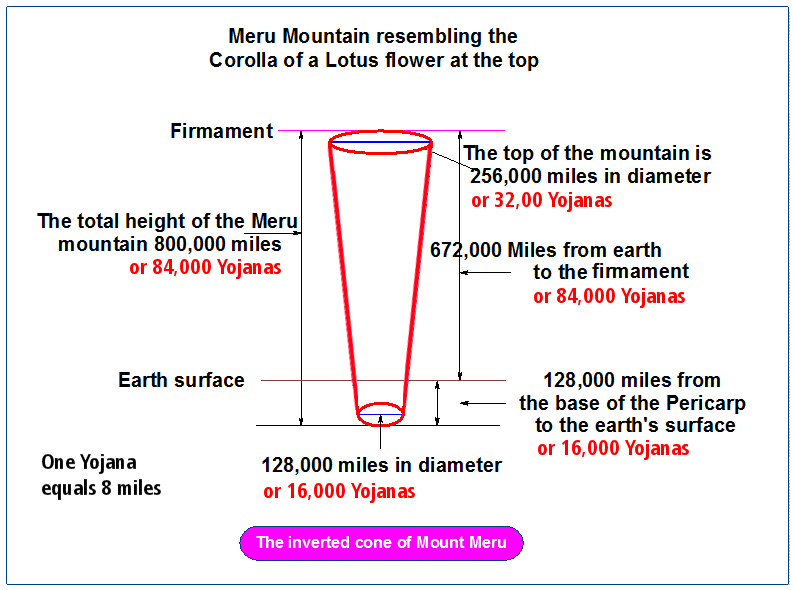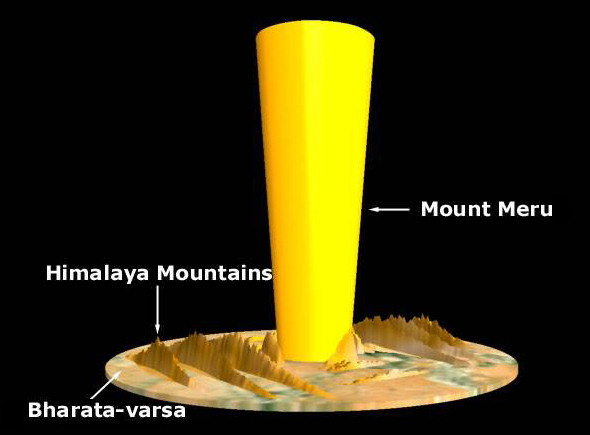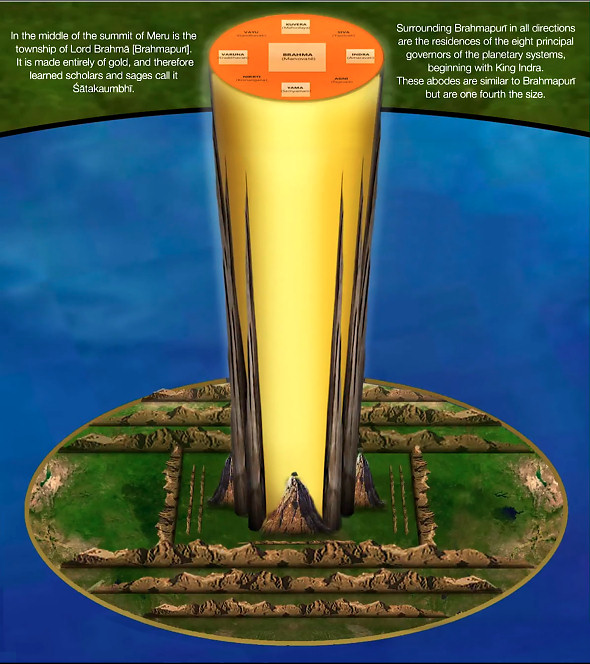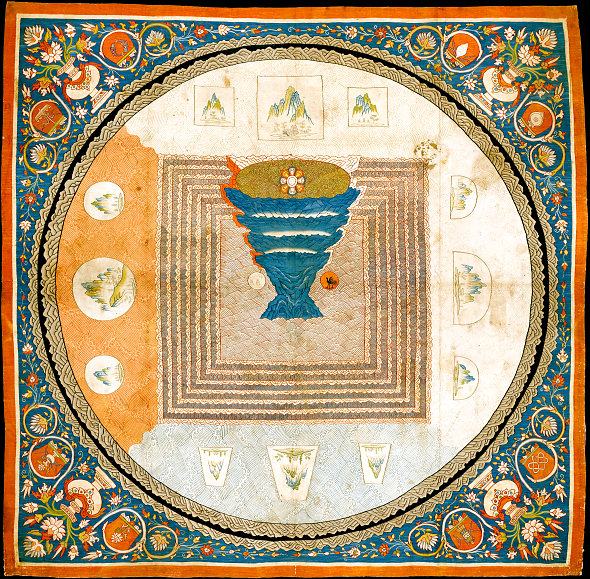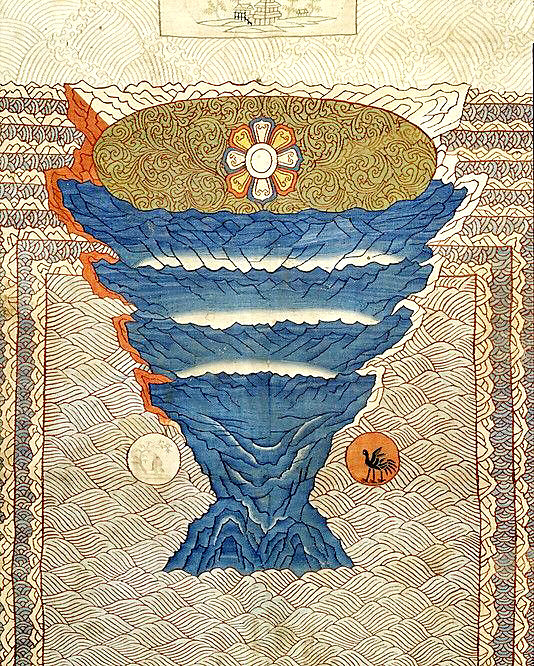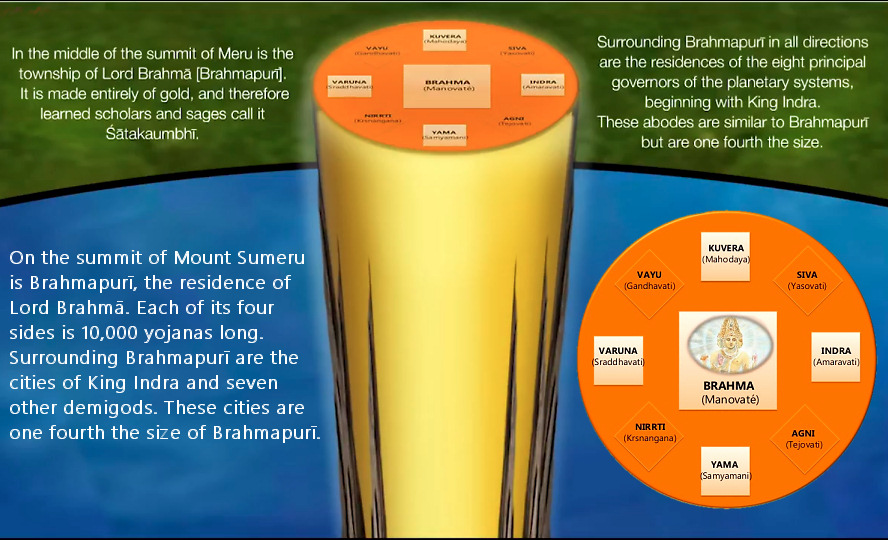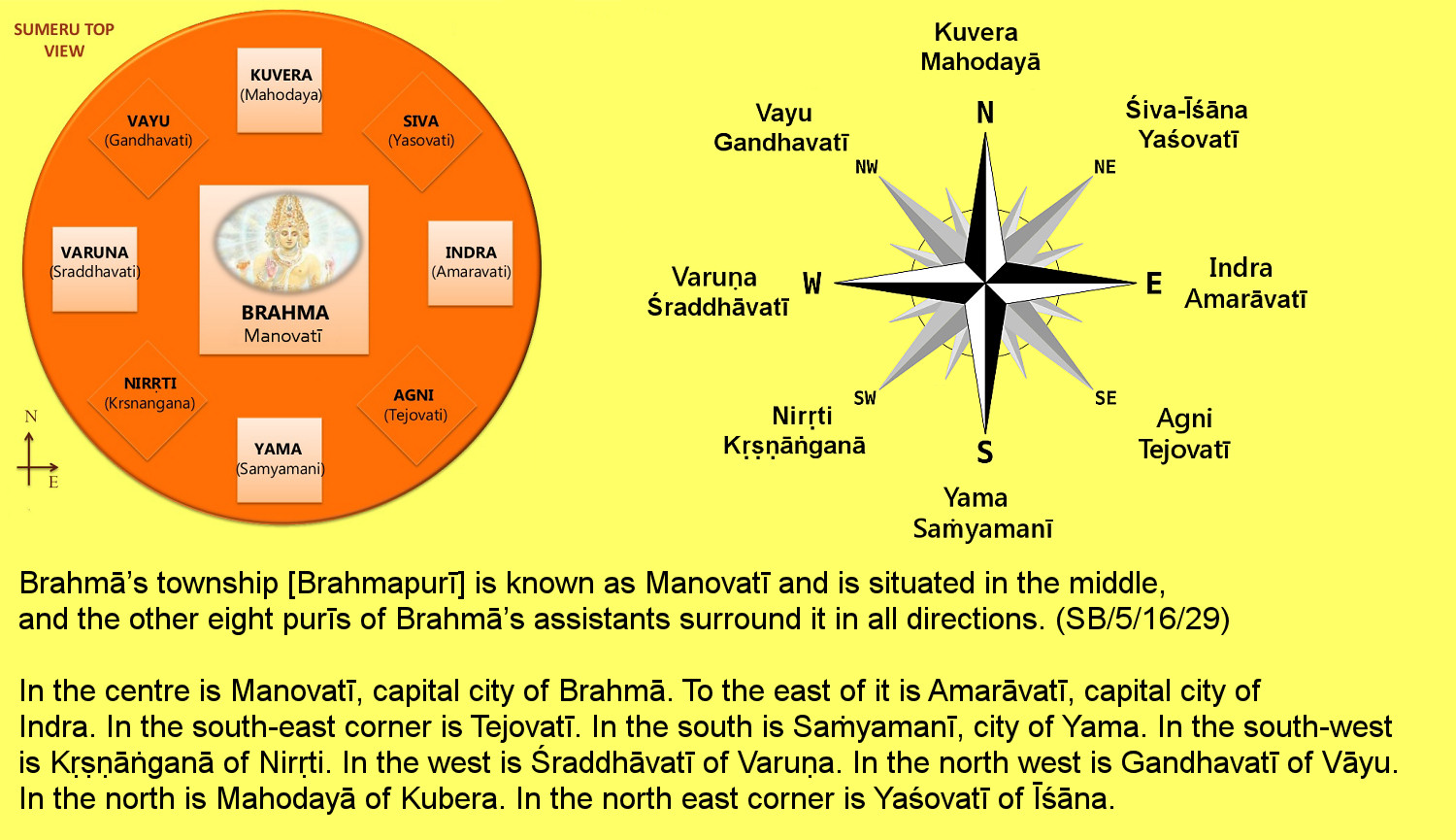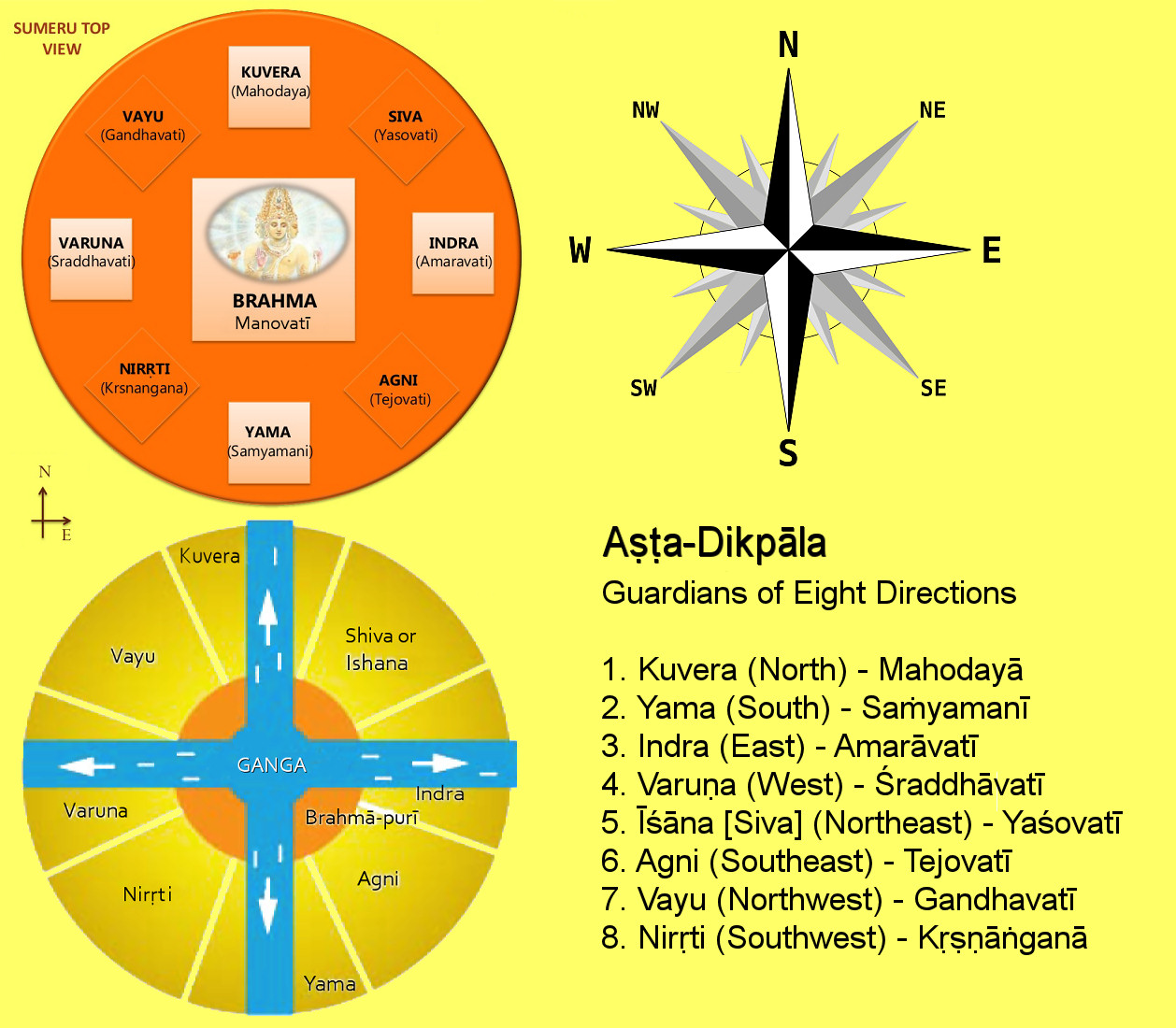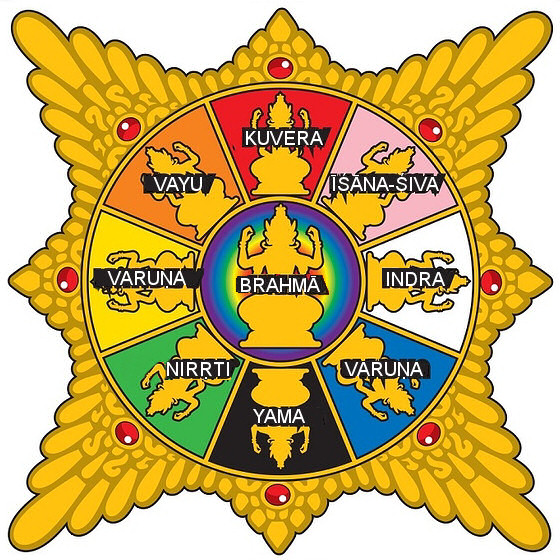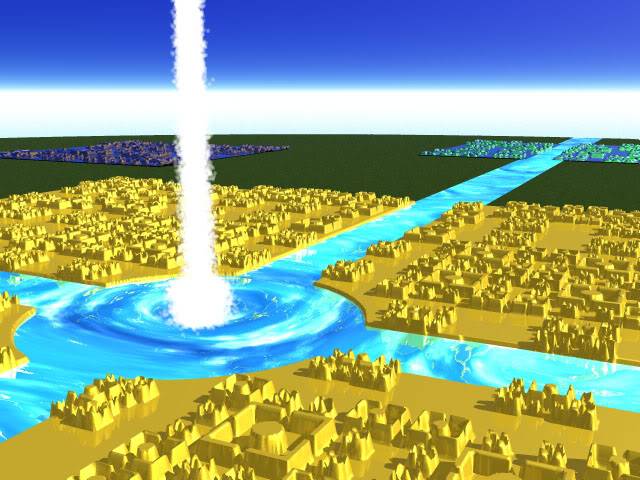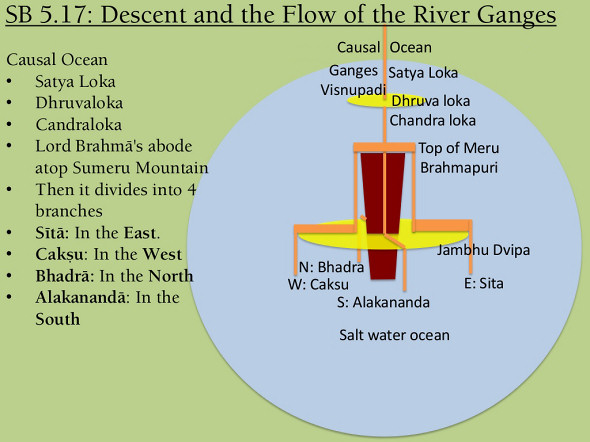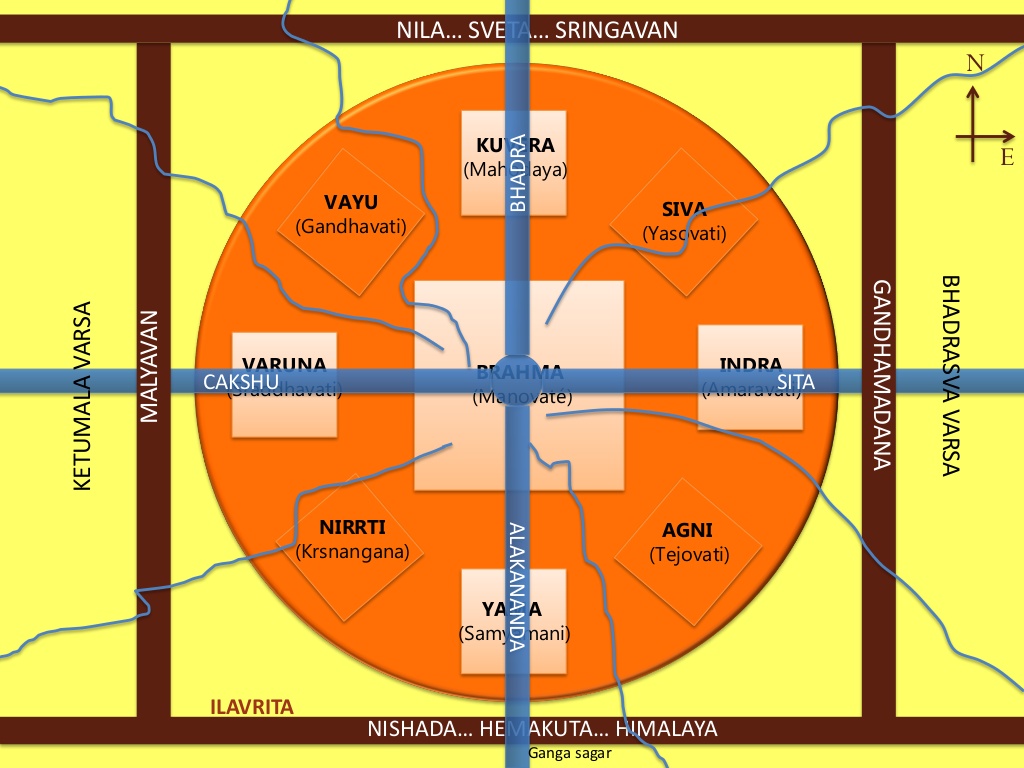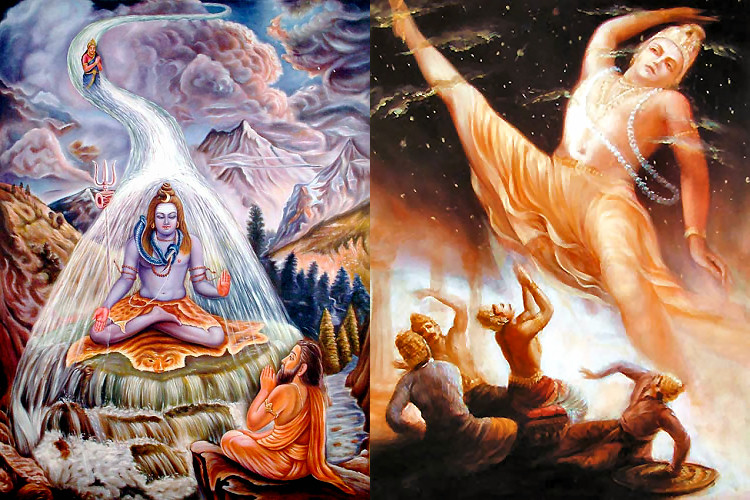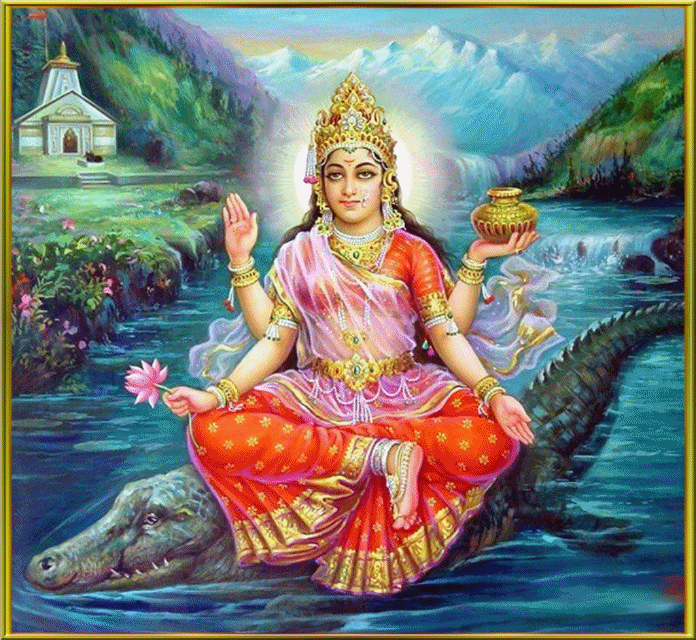
STUDYING THE STRUCTURE OF THE UNIVERSE
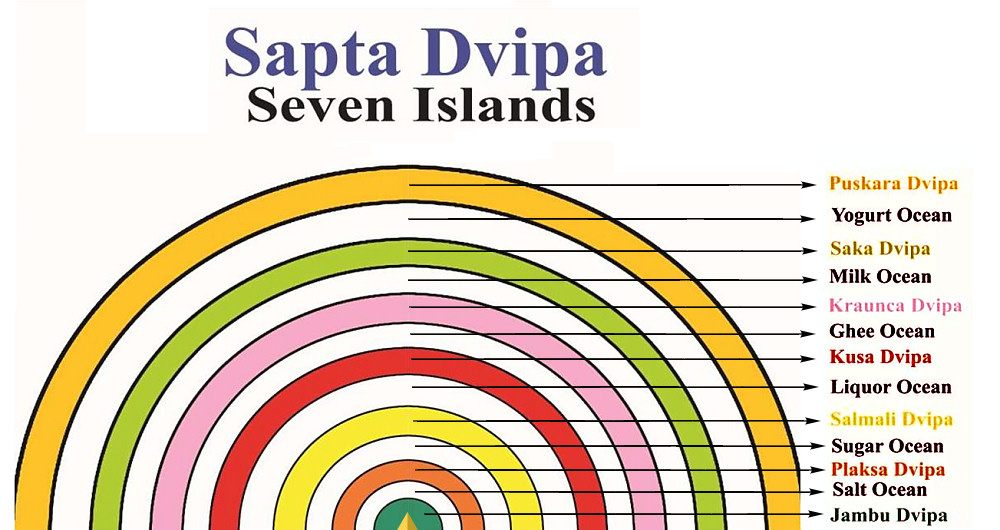
The seven islands of Bhū-maṇḍala
1. Definition of Bhū-maṇḍala and its seven islands [dvīpas]
2. Defining Jambūdvīpa the center island of Bhū-maṇḍala
3. Division of Jambūdvīpa into Nine Varṣas or Regions
4. Definition of Bhārata-varṣa as one of the nine regions of Jambūdvīpa
5. The Nine Varṣas, different parts of Jambūdvīpa
6. The Math & Dimensions of Jambūdvīpa
7. New Puranic Maps of Jambūdvīpa
1. Defining Bhū-maṇḍala and its seven islands or dvīpas
The definition of Bhū-maṇḍala and its center island Jambūdvīpa has been given in the Śrīmad-Bhāgavatam as follows:
The planetary system known as Bhū-maṇḍala resembles a lotus flower, and its seven islands resemble the whorl of that flower. The length and breadth of the island known as Jambūdvīpa, which is situated in the middle of the whorl, are one million yojanas [eight million miles]. Jambūdvīpa is round like the leaf of a lotus flower. (sb/5/16/5)
This earth planet [Bhū-maṇḍala] is divided into seven dvīpas by seven oceans, and the central dvīpa, called Jambūdvīpa, is divided into nine varṣas, or parts, by eight huge mountains. (SB 1.16.12, Purport)
According to Purāṇic cosmography, the world (Bhū-maṇḍala) is divided into seven concentric island continents (sapta-dvipa) separated by the seven encircling oceans, each double the size of the preceding one (going out from within). The seven intermediate oceans consist of salt-water, sugarcane juice, wine, ghee, yogurt, milk and water respectively.
The seven islands (dvīpas) [of Bhū-maṇḍala] are known as (1) Jambu, (2) Śāka, (3) Śālmalī, (4) Kuśa, (5) Krauñca, (6) Gomeda, or Plakṣa, and (7) Puṣkara. The planets are called dvīpa. Outer space is like an ocean of air. Just as there are islands in the watery ocean, these planets in the ocean of space are called dvīpas, or islands in outer space.
The continent of Jambūdvīpa forms the innermost concentric island in the above scheme. Its name is said to derive from a huge Jambū tree.
It is to be understood that all the dvīpas, or islands, are surrounded by different types of oceans, and it is said herein that the breadth of each ocean is the same as that of the island it surrounds. The length of the oceans, however, cannot equal the length of the islands. According to Vīrarāghava Ācārya, the breadth of the first island is 100,000 yojanas. One yojana equals eight miles, and therefore the breadth of the first island is calculated to be 800,000 miles. The water surrounding it must have the same breadth, but its length must be different. (sb/5/1/33)
MAP OF JAMBŪDVĪPA
2. Defining Jambūdvīpa the center island of Bhū-maṇḍala
In Jambūdvīpa there are nine khaṇḍas [varṣas or regions], known as (1) Bhārata, (2) Kinnara or Kimpuruṣa, (3) Hari, (4) Kuru, (5) Hiraṇmaya, (6) Ramyaka, (7) Ilāvṛta, (8) Bhadrāśva and (9) Ketumāla. These are different parts of the Jambūdvīpa. A valley between two mountains is called a khaṇḍa or varṣa. (cc/madhya/20/218)
Jambūdvīpa (Sanskrit: जम्बूद्वीप) is the dvīpa (island, region or continent) of the terrestrial world, as envisioned in vedic cosmology, which is the realm where ordinary human beings live. The other worlds (varṣas, islands, dvipas) are inaccessible for human beings.
3. Division of Jambūdvīpa into Nine Varṣas or Regions
In Jambūdvīpa there are nine divisions of land, each with a length of 9,000 yojanas [72,000 miles]. There are eight mountains that mark the boundaries of these divisions and separate them nicely. (sb/5/16/6)
MAP OF JAMBŪDVĪPA
4. Definition of Bhārata-varṣa as one of the nine regions of Jambūdvīpa
Bhārata-varṣa: This part of the world is also one of the nine varṣas of the Jambūdvīpa. A description of Bhārata-varṣa is given in the Mahābhārata (Bhīṣma-parva, Chapters 9 and 10).
In the center of Jambūdvīpa is Ilāvṛta-varṣa, and south of Ilāvṛta-varṣa is Hari-varṣa. The description of these varṣas is given in the Mahābhārata (Sabhā-parva 28.7-8) as follows:
It is mentioned here that the women in both these varṣas are beautiful, and some of them are equal to the Apsarās, or heavenly women. (sb/1/16/12)
The tract of land known as Bhārata-varṣa is the field of activities, and the other eight varṣas are for persons who are meant to enjoy heavenly comfort. In each of these eight beautiful provinces, the celestial denizens enjoy various standards of material comfort and pleasure. A different incarnation of the Supreme Personality of Godhead distributes His mercy in each of the nine varṣas of Jambūdvīpa. (sb/5/17/17_summary)
Description of Jambūdvīpa from Śrīmad-Bhāgavatam
In Jambūdvīpa there are nine divisions of land, each with a length of 9,000 yojanas [72,000 miles]. There are eight mountains that mark the boundaries of these divisions and separate them nicely. (sb/5/16/6-29)
5. THE NINE VARṢAS, DIFFERENT PARTS OF JAMBŪDVĪPA
(1) Bhārata-varṣa EIGHT DIVIDING MOUNTAINS
(2) Kinnara-varṣa [Kimpuruṣa] • Śṛṅgavān
(3) Hari-varṣa • Śveta
(4) Kuru-varṣa • Nīla
(5) Hiraṇmaya-varṣa • Mālyavān
(6) Ramyaka-varṣa • Gandhamādana
(7) Ilāvṛta-varṣa • Niṣadha
(8) Bhadrāśva-varṣa • Hemakūṭa
(9) Ketumāla-varṣa • Himālaya
This earth planet is divided into seven parts, and according to others it is divided into nine parts. This earth is called Jambūdvīpa and is divided into nine varṣas. Bhārata-varṣa is one of the above mentioned nine varṣas. Such varṣas are known as continents in the modern geographical context. (sb/1/16/12)
A description of Bhārata-varṣa is given in the Mahābhārata (Bhīṣma Parva, Chapters 9-10). When MahārājaYudhiṣṭhira performed a horse sacrifice, the inhabitants of these countries were also present to take part in the festival, and they paid tributes to the Emperor. This part of the world is called Kimpuruṣa-varṣa, or sometimes the Himalayan provinces (Himavatī). It is said that Śukadeva Gosvāmī was born in these Himalayan provinces, and he came to Bhārata-varṣa after crossing the Himalayan countries. In other words, Mahārāja Parīkṣit conquered all the world, namely all the continents adjoining all the seas and oceans in all directions, namely the eastern, western, northern and southern parts of the world. (sb/1/16/12)
Mahārāja Parīkṣit then conquered all parts of the earthly planet—Bhadrāśva, Ketumāla, Bhārata, the northern Kuru, Kimpuruṣa, etc.—and exacted tributes from their respective rulers. (sb/1/16/12)
ILĀVṚTA-VARṢA - THE CENTER ISLAND OF JAMBŪDVĪPA
DESCRIPTION OF ILAVRITA-VARSA AND
THE REGION SURROUNDING MOUNT MERU:
O Mahārāja Parīkṣit, best of the Bharata dynasty, between these four mountains are four huge lakes. The water of the first tastes just like milk; the water of the second, like honey; and that of the third, like sugarcane juice. The fourth lake is filled with pure water. The celestial beings such as the Siddhas, Cāraṇas and Gandharvas, who are also known as demigods, enjoy the facilities of those four lakes. Consequently they have the natural perfections of mystic yoga, such as the power to become smaller than the smallest or greater than the greatest. There are also four celestial gardens named Nandana, Caitraratha, Vaibhrājaka and Sarvatobhadra. (sb/5/16/13-14)
Śukadeva Gosvāmī said: In the tract of land known as Ilāvṛta-varṣa, the only male person is Lord Śiva, the most powerful demigod. Goddess Durgā, the wife of Lord Śiva, does not like any man to enter that land. If any foolish man dares to do so, she immediately turns him into a woman. I shall explain this later [in the Ninth Canto of Śrīmad-Bhāgavatam]. (sb/5/17/15)
In Ilāvṛta-varṣa, Lord Śiva is always encircled by ten billion maidservants of goddess Durgā, who minister to him. The quadruple expansion of the Supreme Lord is composed of Vāsudeva, Pradyumna, Aniruddha and Saṅkarṣaṇa. Saṅkarṣaṇa, the fourth expansion, is certainly transcendental, but because his activities of destruction in the material world are in the mode of ignorance, He is known as tāmasī, the Lord’s form in the mode of ignorance. Lord Śiva knows that Saṅkarṣaṇa is the original cause of his own existence, and thus he always meditates upon Him in trance by chanting the following mantra. (5/17/16)
śrī-bhagavān uvāca
oṁ namo bhagavate mahā-puruṣāya
sarva-guṇa-saṅkhyānāyānantāyāvyaktāya nama iti.
The most powerful Lord Śiva says: O Supreme Personality of Godhead, I offer my respectful obeisances unto You in Your expansion as Lord Saṅkarṣaṇa. You are the reservoir of all transcendental qualities. Although You are unlimited, You remain unmanifest to the nondevotees. (sb/5/17/17)
LEFT IMAGE: Wooden model of Meru made in Orissa, India, 19th century. The view is straight down on Mt. Meru, which is circled by mountain ranges (three ranges on two of the continents, one on the other two continents); four rivers flow from Mt. Meru to the four points of the compass down the middle of island-continents and flow towards the ocean
THE EIGHT GREAT MOUNTAINS DIVIDING JAMBŪDVĪPA
Jambūdvīpa continent has 8 great mountains. Six horizontal and two vertical mountain chains divide Jambūdvīpa into nine regions, or varṣas. The southernmost region is called Bhārata-varṣa. The names of these 8 great mountains are:
1. Śṛṅgavān, 2. Śveta, 3. Nīla, 4. Mālyavān,
5. Gandhamādana, 6. Niṣadha, 7. Hemakūṭa, 8. Himālaya
SUMERU AND ITS ADJOINING MOUNTAINS
Just north of Ilāvṛta-varṣa—and going further northward, one after another—are three mountains named Nīla, Śveta and Śṛṅgavān. These mark the borders of the three varṣas named Ramyaka, Hiraṇmaya and Kuru and separate them from one another. The width of these mountains is 2,000 yojanas [16,000 miles]. Lengthwise, they extend east and west to the beaches of the ocean of salt water. Going from south to north, the length of each mountain is one tenth that of the previous mountain, but the height of them all is the same.
In the same way, west and east of Ilāvṛta-varṣa are two great mountains named Mālyavān and Gandhamādana respectively. These two mountains, which are 2,000 yojanas [16,000 miles] high, extend as far as Nīla Mountain in the north and Niṣadha in the south. They indicate the borders of Ilāvṛta-varṣa and also the varṣas known as Ketumāla and Bhadrāśva.
On the four sides of the great mountain known as Sumeru are four mountains—Mandara, Merumandara, Supārśva and Kumuda—which are like its belts. The length and height of these mountains are calculated to be 10,000 yojanas [80,000 miles]. (sb/5/16/11)
There are other mountains beautifully arranged around the foot of Mount Meru like the filaments around the whorl of a lotus flower. Surrounding Sumeru Mountain like filaments of the whorl of a lotus are twenty mountain ranges such as Kuraṅga, Kurara, Kusumbha, Vaikaṅka and Trikūṭa. To the east of Sumeru are the mountains Jaṭharaand Devakūṭa, to the west are Pavana and Pāriyātra, to the south are Kailāsa and Karavīra, and to the north are Triśṛṅga and Makara. These eight mountains are about 18,000 yojanas long, 2,000 yojanas wide and 2,000 yojanas high.
BUDDHIST – CHINESE – MOUNT SUMERU
SUMERU OR MOUNT MERU
Amidst these divisions, or varṣas, is the varṣa named Ilāvṛta, which is situated in the middle of the whorl of the lotus. Within Ilāvṛta-varṣa is Sumeru Mountain, which is made of gold. Sumeru Mountain is like the pericarp of the lotuslike Bhū-maṇḍala planetary system.
Sumeru Mountain is like the pericarp of the lotuslike Bhū-maṇḍala planetary system.
The mountain’s height is the same as the width of Jambūdvīpa—or, in other words, 100,000 yojanas [800,000 miles]. Of that, 16,000 yojanas [128,000 miles] are within the earth, and therefore the mountain’s height above the earth is 84,000 yojanas [672,000 miles]. The mountain’s width is 32,000 yojanas [256,000 miles] at its summit and 16,000 yojanas at its base. (sb/5/16/7)
MOUNT SUMERU – CENTER OF JAMBŪDVĪPA
TOP IMAGE: Buddhist Meru Mandala with Sumeru mountain in the center
In the middle of the summit of Meru is the township of Lord Brahmā. Each of its four sides is calculated to extend for ten million yojanas [eighty million miles]. It is made entirely of gold, and therefore learned scholars and sages call it Śātakaumbhī. (SB 5.16.29)
MANOVATĪ - THE TOWNSHIP OF LORD BRAHMĀ [Śātakaumbhī]
Surrounding Brahmā-purī in all directions are the residences of the eight principal governors of the planetary systems, beginning with King Indra. These abodes are similar to Brahmapurī but are one fourth the size.
Śrīla Viśvanātha Cakravartī Ṭhākura confirms that the townships of Lord Brahmā and the eight subordinate governors of the planetary systems, beginning with Indra, are mentioned in other Purāṇas.
Brahmā’s township is known as Manovatī, and those of his assistants such as Indra and Agni are known as Amarāvatī, Tejovatī, Saṁyamanī, Kṛṣṇāṅganā, Śraddhāvatī, Gandhavatī, Mahodayā and Yaśovatī.
Brahmapurī is situated in the middle, and the other eight purīs surround it in all directions. (sb/5/16/29)
There are ten directions, namely east, west, south, north, the four corners northeast, southeast, northwest and southwest and up and down. These are the ten directions. Besides the eight guardians of directions, the following two are added: Brahma (Zenith, meaning "vertically the farthest up") and Vishnu (Nadir, meaning "the downward direction")
1. Kuvera (North) - Mahodayā |
|
In the centre is Manovatī, capital city of Brahmā. To the east of it is Amarāvatī, capital city of Indra. In the south-east corner is Tejovatī. In the south is Saṁyamanī, city of Yama. In the south-west is Kṛṣṇāṅganā of Nirṛti. In the west is Śraddhāvatī of Varuṇa. In the north west is Gandhavatī of Vāyu. In the north is Mahodayā of Kubera. In the north east corner is Yaśovatī of Īśāna
The living entities residing on Sumeru Mountain are always very warm, as at midday, because for them the sun is always overhead. Although the sun moves counterclockwise, facing the constellations, with Sumeru Mountain on its left, it also moves clockwise and appears to have the mountain on its right because it is influenced by the dakṣiṇāvarta wind. People living in countries at points diametrically opposite to where the sun is first seen rising will see the sun setting, and if a straight line were drawn from a point where the sun is at midday, the people in countries at the opposite end of the line would be experiencing midnight. Similarly, if people residing where the sun is setting were to go to countries diametrically opposite, they would not see the sun in the same condition. (sb/5/21/8-9)
DESCENT AND FLOW OF THE RIVER GANGES
On top of Mount Meru, the Ganges divides into four branches, each of which gushes in a different direction [east, west, north and south]. These branches, known by the names Sītā, Alakanandā, Cakṣu and Bhadrā, flow down to the ocean. (sb/5/17/5-11)
The branch of the Ganges known as the Sītā flows through Brahmapurī atop Mount Meru, and from there it runs down to the nearby peaks of the Kesarācala Mountains, which stand almost as high as Mount Meru itself. These mountains are like a bunch of filaments around Mount Meru. From the Kesarācala Mountains, the Ganges falls to the peak of Gandhamādana Mountain and then flows into the land of Bhadrāśva-varṣa. Finally it reaches the ocean of salt water in the west.
The branch of the Ganges known as Cakṣu falls onto the summit of Mālyavān Mountain and from there cascades onto the land of Ketumāla-varṣa. The Ganges flows incessantly through Ketumāla-varṣa and in this way also reaches the ocean of salt water in the West.
The branch of the Ganges known as Bhadrā flows from the northern side of Mount Meru. Its waters fall onto the peaks of Kumuda Mountain, Mount Nīla, Śveta Mountain and Śṛṅgavān Mountain in succession. Then it runs down into the province of Kuru and, after crossing through that land, flows into the saltwater ocean in the north.
Similarly, the branch of the Ganges known as Alakanandā flows from the southern side of Brahmapurī [Brahma-sadana]. Passing over the tops of mountains in various lands, it falls down with fierce force upon the peaks of the mountains Hemakūṭa and Himakūṭa. After inundating the tops of those mountains, the Ganges falls down onto the tract of land known as Bhārata-varṣa, which she also inundates. Then the Ganges flows into the ocean of salt water in the south. Persons who come to bathe in this river are fortunate. It is not very difficult for them to achieve with every step the results of performing great sacrifices like the Rājasūya and Aśvamedha yajñas.
Many other rivers, both big and small, flow from the top of Mount Meru. These rivers are like daughters of the mountain, and they flow to the various tracts of land in hundreds of branches.
The Ganges River, emanating from the lotus feet of the Lord, inundates the heavenly planets, especially the moon, and then flows through Brahmapurī atop Mount Meru. Here the river divides into four branches (known as Sītā, Alakanandā, Cakṣu and Bhadrā), which then flow down to the ocean of salt water. The branch known as Sītā flows through Śekhara-parvata and Gandhamādana-parvata and then flows down to Bhadrāśva-varṣa, where it mixes with the ocean of salt water in the West. The Cakṣu branch flows through Mālyavān-giri and, after reaching Ketumāla-varṣa, mixes with the ocean of salt water in the West. The branch known as Bhadrā flows onto Mount Meru, Mount Kumuda, and the Nīla, Śveta and Śṛṅgavān mountains before it reaches Kuru-deśa, where it flows into the ocean of salt water in the north. The Alakanandā branch flows through Brahmālaya, crosses over many mountains, including Hemakūṭa and Himakūṭa, and then reaches Bhārata-varṣa, where it flows into the southern side of the ocean of salt water. Many other rivers and their branches flow through the nine varṣas.
The Seventeenth Chapter describes the origin of the Ganges River and how it flows in and around Ilāvṛta-varṣa. There is also a description of the prayers Lord Śiva offers to Lord Saṅkarṣaṇa, part of the quadruple expansions of the Supreme Personality of Godhead. Lord Viṣṇu once approached BaliMahārāja while the King was performing a sacrifice. The Lord appeared before him as Trivikrama, or Vāmana, and begged alms from the King in the form of three steps of land. With two steps, Lord Vāmana covered all three planetary systems and pierced the covering of the universe with the toes of His left foot. A few drops of water from the Causal Ocean leaked through this hole and fell on the head of Lord Śiva, where they remained for one thousand millenniums. These drops of water are the sacred Ganges River. It first flows onto the heavenly planets, which are located on the soles of Lord Viṣṇu’s feet. The Ganges River is known by many names, such as the Bhāgīrathī and the Jāhnavī. It purifies Dhruvaloka and the planets of the seven sages because both Dhruva and the sages have no other desire than to serve the Lord’s lotus feet. (sb/5/17/17_summary)
GANGA DEVI
